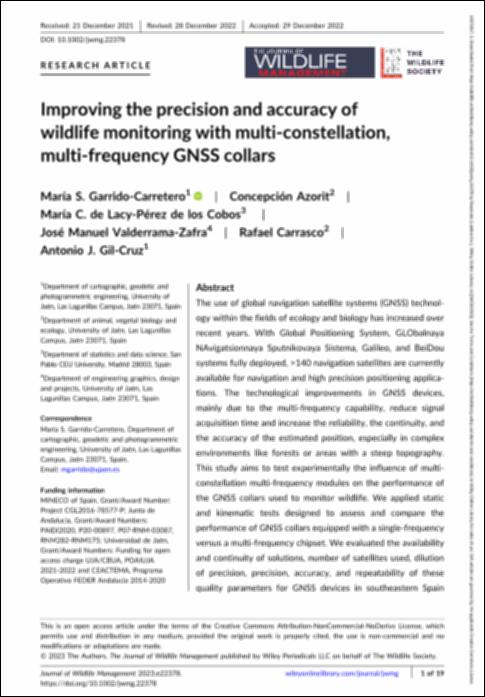Por favor, use este identificador para citar o enlazar este ítem:
http://hdl.handle.net/10637/14582Improving the precision and accuracy of wildlife monitoring with multi-constellation, multi-frequency GNSS collars
| Título : | Improving the precision and accuracy of wildlife monitoring with multi-constellation, multi-frequency GNSS collars |
| Autor : | Garrido-Carretero, María S. Azorit, Concepcion de Lacy Pérez de los Cobos, María Clara Valderrama-Zafra, Jose Manuel Carrasco, Rafael Gil-Cruz, Antonio J. |
| Materias: | Global navigation satellite systems; GNSS collar; Kinematic positioning; Location device |
| Editorial : | Wiley |
| Citación : | Garrido-Carretero, María S., et al. Improving the precision and accuracy of wildlife monitoring with multi‐constellation, multi‐frequency GNSS collars. The Journal of Wildlife Management, 2023, vol. 87, no 4, p. e22378. |
| Resumen : | The use of global navigation satellite systems (GNSS) technology within the fields of ecology and biology has increased over recent years. With Global Positioning System, GLObalnaya NAvigatsionnaya Sputnikovaya Sistema, Galileo, and BeiDou systems fully deployed, >140 navigation satellites are currently available for navigation and high precision positioning applications. The technological improvements in GNSS devices, mainly due to the multi-frequency capability, reduce signal acquisition time and increase the reliability, the continuity, and the accuracy of the estimated position, especially in complex environments like forests or areas with a steep topography. This study aims to test experimentally the influence of multi-constellation multi-frequency modules on the performance of the GNSS collars used to monitor wildlife. We applied static and kinematic tests designed to assess and compare the performance of GNSS collars equipped with a single-frequency versus a multi-frequency chipset. We evaluated the availability and continuity of solutions, number of satellites used, dilution of precision, precision, accuracy, and repeatability of these quality parameters for GNSS devices in southeastern Spain from February 2021 to June 2022. The results confirmed that the multi-constellation multi-frequency GNSS collar showed a stable and good performance in terms of the number of satellites used (>10), horizontal dilution of precision (<1.3), fix success rate (100%), mean location error (<1.5 m), and circular error probability (CEP), which was better by approximately one order of magnitude than the single-frequency collar (1-10 m). The use of reliable and accurate GNSS devices will expand our knowledge of animal behavior and the interactions between species. Multi-frequency GNSS collars allow collection of accurate locations, providing fine-scale information about animal behavior (e.g., feeding strategies, competition for resources), whereas the single-frequency GNSS collars can used for broad-scale studies (e.g., home ranges, habitat use). |
| URI : | http://hdl.handle.net/10637/14582 |
| Derechos: | http://creativecommons.org/licenses/by-nc-nd/4.0/deed.es OpenAcces |
| Fecha de publicación : | 29-dic-2022 |
| Centro : | Universidad San Pablo-CEU |
| Aparece en las colecciones: | Facultad de Económicas y CC Empresariales |
Los ítems de DSpace están protegidos por copyright, con todos los derechos reservados, a menos que se indique lo contrario.


